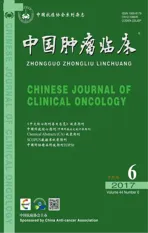早期宫颈癌术后预后与不同放疗方式的疗效及并发症比较*
2017-04-20涂剑楠王新玲张静雅叶伟军金华
涂剑楠王新玲张静雅叶伟军金华
早期宫颈癌术后预后与不同放疗方式的疗效及并发症比较*
涂剑楠①王新玲②张静雅①叶伟军③金华①
目的:探讨影响早期宫颈癌患者术后预后的因素和不同放疗方式的疗效及并发症情况。方法:回顾性分析2013年3月至9月100例新疆医科大学附属肿瘤医院及中山大学附属肿瘤医院收治的早期宫颈癌术后患者资料,并对影响患者预后的因素进行分析。根据放疗方式分为常规放疗(conventional radiotherapy,CRT)组50例,图像引导调强放疗(image guided radiotherapy,IGRT)组50例,并比较两组的疗效和并发症情况。结果:100例患者3年生存率和无瘤生存率分别为89%和78%。CRT组和IGRT组3年生存率分别为78.57%和89.06%,两组比较差异具有统计学意义(P=0.034);CRT组和IGRT组3年无瘤生存率分别为66.67%和87.36%,两组比较差异具有统计学意义(P=0.042)。CRT组和IGRT组早期、晚期并发症的比较差异具有统计学意义(P<0.05)。单因素分析显示宫旁浸润、淋巴结转移、肿瘤浸润深度、淋巴脉管间隙浸润、神经侵犯、术后放疗与早期宫颈癌3年生存率相关(P<0.05)。Cox多因素分析显示术后放疗方式、宫旁浸润、淋巴结转移、淋巴脉管间隙浸润、神经侵犯及肿瘤浸润深度均为影响早期宫颈癌患者预后的独立危险因素。结论:早期宫颈癌的预后是多因素相互作用的结果,术后IGRT组3年生存率明显优于CRT组,放疗不良反应小,有益于患者的生存质量。
宫颈癌 放射治疗 预后 疗效 并发症
宫颈癌是全球女性第四大常见恶性肿瘤[1],我国每年宫颈癌新发病例约10万人,居我国女性生殖系统恶性肿瘤首位[2]。早期宫颈癌手术切除与根治性放疗的疗效相当[3],其中术后ⅠB2、ⅡA2期患者多存在高危或中危因素,50%~80%患者需行放疗。根据NCCN宫颈癌临床实践指南(2016年),术后病理切缘阳性、宫旁浸润、盆腔淋巴结阳性被认为是“高危因素”,对具备任何一项因素者均推荐术后行盆腔放疗,阴道切缘阳性者的阴道近距离放疗可增加治疗疗效。对无“高危因素”的“中危因素”者中的淋巴脉管间隙浸润、深层间质浸润和原发肿瘤较大者也需行盆腔放疗。本研究探讨影响早期宫颈癌患者的术后预后因素,及不同放疗方式的疗效及并发症情况。
1 材料与方法
1.1 一般资料
选取新疆医科大学附属肿瘤医院及中山大学附属肿瘤医院2013年3月至9月收治的100例ⅠB~ⅡA期宫颈癌术后患者,年龄为34~65岁,中位年龄为40岁,临床资料完整,术前未行新辅助治疗,无其他部位原发肿瘤。术后病理提示具有“高危(和)或中危因素”。根据放疗方式分为常规放疗(conventional ra⁃diotherapy,CRT)组50例,图像引导调强放疗(image guided radiotherapy,IGRT)组50例。KPS评分>80分,具有放疗适应证,治疗前签署知情同意书。放疗期间给予顺铂40 mg/m2,静脉滴注,1次/周。
1.2 方法
1.2.1 CRT 盆腔基本照射野采用6MVX线前后两野对穿照射。上界位于第4、5腰椎水平,下界位于闭孔下缘水平,两侧缘位于真骨盆最大径旁开2.0 cm,包括髂总、两侧盆壁、骶前淋巴结和残端,放疗剂量为45 Gy。
1.2.2 IGRT 采用仰卧位热塑体膜固定患者的腹、盆腔。按层厚5 mm行CT扫描,从胸10椎体下缘至坐骨结节下缘5 cm。扫描前所有患者均行膀胱残余尿测定。放疗医师根据ICRU83号文件完成靶区勾画。分割剂量为1.8 Gy/次,处方剂量45 Gy,95%以上的计划靶区(planning target volume,PTV)达到处方剂量,给予危及器官一定条件的剂量限制。患者前6次(1次/天)与后4次(1次/周)治疗前行Varian直线加速器系统机载CBCT扫描,CBCT图像与定位CT图像进行匹配,比对结果在允许误差范围内则可进行治疗,超出误差允许范围,系统自动形成新的摆位参数并直接修正。
1.2.3 随访 所有病例通过电话及临床资料随访,随访时间截止至2016年12月31日。总生存(overall survival,OS)为从初次治疗至死亡或末次随访。无瘤生存(disease free survival,DFS)为从初次治疗至任何部位出现复发、转移或末次随访。复发、转移主要根据症状、体征、辅助检查及穿刺活检病理诊断。并发症分级评价标准根据放射肿瘤协作组RTOG放射损伤标准(1995年)。
1.3 统计学分析
采用SPSS 19.0软件进行统计学分析。计数资料采用χ2检验或Fisher精确概率法检验。生存分析采用Kaplan-Meier曲线,单因素分析采用Log rank检验,多因素分析采用Cox风险回归模型进行。以P<0.05为差异具有统计学意义。
2 结果
2.1 预后因素分析
本研究对年龄、FIGO分期、宫旁浸润、淋巴结转移、肿瘤浸润深度、淋巴脉管间隙浸润、神经侵犯、肿瘤直径、术后放疗方式采用Log rank检验进行单因素分析,结果显示术后放疗方式、宫旁浸润、淋巴结转移、淋巴脉管间隙浸润、神经侵犯、肿瘤浸润深度与预后相关(P<0.05,表1)。Cox多因素分析结果显示,术后放疗方式、宫旁浸润、淋巴结转移、淋巴脉管间隙浸润、神经侵犯及肿瘤浸润深度均是影响早期宫颈癌患者预后的独立危险因素(表2)。

表1 100例早期宫颈癌术后患者3年生存率的单因素分析Table 1 Univariate analysis of 3-year overall survival rate for 100 postoperative patients of early cervical squamous cell cancer

表1 100例早期宫颈癌术后患者3年生存率的单因素分析(续表1)Table 1 Univariate analysis of 3-year overall survival rate for 100 postoperative patients of early cervical squamous cell cancer

表2 100例早期宫颈癌术后患者3年生存率Cox多因素分析Table 2 Cox multivariate analyses of 3-year overall survival rate for 100 postoperative patients of early cervical squamous cell cancer
2.2 CRT和IGRT组患者的临床疗效比较
所有患者均完成了术后放化疗,100例患者均随访了36个月,随访率为100%,3年生存率和无瘤生存率分别为89%和78%。其中CRT组患者3年内局部复发6例,死亡9例(其中2例死于其他疾病),3例远处转移;IGRT组患者3年内局部复发1例,2例死亡,1例远处转移。CRT组和IGRT组3年生存率为78.57%和89.06%,两组比较差异具有统计学意义(P=0.034,图1);CRT组和IGRT组3年无瘤生存率为66.67%和87.36%,两组比较差异具有统计学意义(P=0.042,图2)。
2.3 并发症比较
CRT组早期骨髓抑制、消化道症状、泌尿系症状等并发症的发生例数均高于IGRT组,两组比较差异具有统计学意义(P<0.05,表3)。CRT组晚期放射性直肠炎、放射性膀胱炎、盆腔纤维化等并发症的发生例数均高于IGRT组,两组比较差异具有统计学意义(P<0.05,表4)。

图1 CRT组和IGRT组3年OS生存曲线Figure 1 Three-year overall survival curves of the CRT and IGRT groups

图2 CRT组和IGRT组3年DFS生存曲线Figure 2 Three-year disease-free survival curves of the CRT and IGRT groups

表3 CRT组和IGRT组早期并发症发生例数比较Table 3 Comparison of the number of cases with early complications in the CRT and IGRT group

表4 CRT组和IGRT组晚期并发症发生例数比较Table 4 Comparison of the number of cases with late complications in the CRT and IGRT groups
3 讨论
宫颈癌是全球常见的妇科恶性肿瘤,全球每年新增宫颈癌病例约50万,死亡病例超过20万[4-5]。早期宫颈癌患者术后规范化治疗的5年无瘤生存率达90%[6]。宫颈癌的预后与多种因素相互影响有关,是一个复杂且具有研究意义的问题。本研究发现术后放疗方式、宫旁浸润、淋巴结转移、淋巴脉管间隙浸润、神经侵犯及肿瘤浸润深度均是影响早期宫颈癌患者预后的独立危险因素,尚未发现年龄、FIGO分期对早期宫颈癌预后有影响。喻晴等[7]对ⅠB~ⅡA期宫颈癌患者术后进行生存评估分析发现,肿瘤分期并不是早期宫颈癌预后的独立风险因素,与本研究结果相似。马晓雯[8]对156例宫颈癌患者术后复发及预后相关因素的分析结果显示,临床分期、病理类型、有无淋巴脉管间隙浸润、有无盆腔淋巴结转移是影响宫颈癌术后复发的临床病理因素;临床分期、有无淋巴脉管间隙浸润、有无盆腔淋巴结转移是影响宫颈癌术后5年生存率的独立因素,与本研究结果相似。岳慧敏等[9]研究发现,神经侵犯与宫颈癌患者预后有关,但不能作为判断宫颈癌预后的不良指标,与本研究结果不相符。虽然神经侵犯并非判断宫颈癌预后的不良指标,但神经转移途径值得进一步关注和研究。
放疗是宫颈癌术后重要辅助治疗手段,在宫颈癌的治疗中占有十分重要的地位。宫颈癌术后患者常出现肠管下移、肠粘连等并发症,照射野内小肠体积增多,增加放射损伤的危险度。放疗过程中的各种不确定性、摆位重复性、器官运动等均影响放疗剂量的准确性[10]。在宫颈癌的治疗中,盆腔CRT取得了一定成效,但靶区体积大、适形度差,使肿瘤周围正常组织受累较多,消化系统和泌尿系统等急慢性并发症的发生率较高。Small等[11]在RTOG0116试验中观察宫颈癌患者的放疗不良反应发现,45例患者3~4级急性非血液系统不良反应发生率为81%,3年随访期内3~4级迟发不良反应发生率高达40%,严重影响了患者的生存质量。IGRT定位精确,肿瘤局部剂量高、剂量梯度下降快,并且能够形成凹形靶区剂量分布,增加肿瘤局部控制率,减少危及直肠、膀胱、小肠、股骨头等器官的损伤,从而减轻放疗并发症,在宫颈癌放疗中被广泛应用。
综上所述,早期宫颈癌术后患者的预后与术后放疗方式、宫旁浸润、淋巴结转移、淋巴脉管间隙浸润、神经侵犯及肿瘤浸润深度等因素密切相关。图像引导调强放疗[12-14]通过在线校正,实时调整摆位误差,提高靶区的剂量,减少危及器官的受照剂量,及时改善剂量分布[15],可较好地弥补传统放疗的局限性,具有很好的临床应用价值。由于本研究样本量较少,后期需要大样本进一步探索,远期临床疗效还需进一步评估。
[1] Torre LA,Bray F,Siegel RL,et al.Global cancer statistics,2012[J]. CA Cancer J Clin,2015,65(2):87-108.
[2] Huang MN,An JS,Du XM.Research progress of radiotherapy for cervical cancer[J].Chin J Obstet Gynecol Pediatr(Electronic Ed),2016,12(1):7-15.[黄曼妮,安菊生,杜霄勐.宫颈癌放射治疗的研究进展[J].中华妇幼临床医学杂志(电子版),2016,12(1):7-15.]
[3] Mabuchi S,Morishige K,Isohashif,et al.Postoperative concurrent nedaplatin-based chemoradiotherapy improves survival in earlystage cervical cancer patients with adverse risk factors[J].Gynecol Oncol,2009,115(3):482-487.
[4] Shazly SA,Murad MH,Dowdy SC,et al.Robotic radical hysterectomy in early stage cervical cancer:A systematic review and metaanalysis[J].Gynecol Oncol,2015,138(2):457-471.
[5] Zong S,Wang X,Yang Y,et al.The use of cisplatin-loaded mucoadhesive nanofibers for local chemotherapy of cervical cancers in mice[J].Eur J Pharm Biopharm,2015,93:127-135.
[6] Wang XF,Chen YB,Han ZL,et al.Comparison of intensity modulated radiotherapy versus three dimensional conformal radiotherapy combined with brachytherapy in the treatment of advanced cervical cancer[J].Chin J Gerontology,2013,33(17):4119-4121.[王晓斐,陈玉丙,韩志龙,等.调强放疗与三维适形放疗联合腔内放疗同步化疗治疗中晚期宫颈癌的对比[J].中国老年学杂志,2013,33(17): 4119-4121.]
[7] Yu Q,Lou XM.Establishment and analysis of survival evaluation system in postoperative patients with cervical cancer of stageⅠB andⅡA[J].Zhejiang Clin Med J,2015,17(3):401-402.[喻 晴,楼向明.ⅠB和ⅡA期宫颈癌患者术后生存评估体系建立与分析[J].浙江临床医学,2015,17(3):401-402.]
[8] Ma XW.Analysis the postoperative recurrence and prognostic factors of 156 patients with the cervical carcinoma[D],Hebei Medical University,2014.[马晓雯.宫颈癌156例术后复发及预后相关因素分析[D],河北医科大学,2014.]
[9] Yue HM,Xue XH,Zhang P.Correlation analysis of perineural invasion and prognosis of cervical cancer[J].Chin J Clinicians(Electronic Ed),2015,9(5):731-734.[岳慧敏,薛秀华,张 萍.宫颈癌神经侵袭与其预后的相关性分析[J].中华临床医师杂志(电子版),2015,9(5): 731-734.]
[10]Ahmad R,Hoogeman MS,Bondar M,et al.Increasing treatment accuracy for cervical cancer patients using correlations between bladder-filling change and cervix-uterus displacements:proof of principle[J].Radiother Oncol,2011,98(3):340-346.
[11]Small W Jr,Winter K,Levenback C,et al.Extended-field irradiation and intracavitary brachytherapy combined with cisplatin and amifostine for cervical cancer with positive para-aorticor high common iliac lymph nodes:result of armⅡof Radiation Therapy Oncology Group(RTOG)0116[J].Int J Gynecol Cancer,2011,21(7):1266-1275.
[12]Bondar ML,Hoogemon MS,Mens JW,et al.Individualized nonadaptive and online-adaptive intensity-modulated radiotherapy treatment strategies for cervical cancer patients based on pretreatment acquired variable bladder filling computer tomography scans[J].Int J Radiat Oncol Biol Phys,2012,83(5):1617-1623.
[13]Langerak T,Heijkoop S,Quint S,et al.Towards automatic plan selection for radiotherapy of cervical cancer by fast automatic segmentation of cone beam CT scans[J].Med Image Comput Assist Interv, 2014,17(Pt1):528-535.
[14]Heijkoop ST,Langerak TR,Quint S,et al.Clinical implementation of an online adaptive plan-of-the-day protocol for nonrigid motion management in locally advanced cervical cancer IMRT[J].Int J Radiat Oncol Biol Phys,2014,90(3):673-679.
[15]Meng QY,Zhang FQ.The influence of new technology on radiation therapy for locally advanced cervical cancer[J].Medical Journal of Peking Union Medical College Hospital,2013,4(4):433-437.[孟庆宇,张福全.放射治疗新技术对局部晚期宫颈癌治疗的影响[J].协和医学杂志,2013,4(4):433-437.]
(2016-12-15收稿)
(2017-03-20修回)
Prognostic analysis and comparison of the efficacy and complication of different radiotherapy techniques for postoperative early cervical squamous cell carcinoma
Jiannan TU1,Xinling WANG2,Jingya ZHANG1,Weijun YE3,Hua JIN1
1Department of Gynecological Radiotherapy,Affiliated Tumor Hospital of Xinjiang Medical University,Urumqi 830011,China;2Department of Gynecology,Affiliated Tumor Hospital of Xinjiang Medical University,Urumqi 830011,China;3Department of Radiotherapy,Affiliated Tumor Hospital of Sun Yat-sen University,Guangzhou 510000,China
Hua JIN;E-mail:jinhua5616@sina.com
Objective:To explore the factors affecting the postoperative prognosis of early cervical squamous cell carcinoma and investigate the different radiotherapy techniques.Methods:A total of 100 postoperative patients of early cervical squamous cell carcinoma treated in Affiliated Tumor Hospital of Xinjiang Medical University and Affiliated Tumor Hospital of Sun Yat-sen University from March to September 2013 were enrolled in our study.The prognostic factors for these patients were analyzed.After being subjected to different postoperative radiotherapy techniques,the efficacy and complications of the techniques were assessed for patients,including 50 cases of conventional radiotherapy(CRT)and 50 cases of image-guided radiotherapy(IGRT).Results:The 3-year overall survival rate was 89%,and the 3-year disease-free survival rate was 78%.The 3-year overall survival rates of the CRT and IGRT groups were 78.57% and 89.06%,respectively.The difference between these rates was statistically significant(P=0.034).The 3-year survival rates of the CRT and IGRT groups were 66.67%and 87.36%,respectively.The difference was statistically significant(P=0.042).The incidence of early and late complications in the CRT group was higher than that in IGRT group,and the difference of P<0.05 was statistically significant. Multivariate analysis showed that postoperative radiotherapy,parametrial invasion,lymph node metastasis,lymphovascular space invasion,perineural invasion,and deep stromal invasion were the independent risk factors for the prognosis of patients with early stage cervical squamous cell carcinoma.Conclusion:Early prognosis of cervical squamous cell carcinoma results from the interaction of multiple factors.The 3-year survival rate of the IGRT group was significantly better than that of the CRT group in the early stage of cervical squamous cell carcinoma.IGRT alleviates acute and chronic toxicities and helps improve the quality of life of patients.
cervical cancer,radiation therapy,prognosis,curative effect,complication

10.3969/j.issn.1000-8179.2017.06.426
①新疆医科大学附属肿瘤医院妇科放射治疗科(乌鲁木齐市830011);②新疆医科大学附属肿瘤医院妇外四科;③中山大学附属肿瘤医院放疗科
*本文课题受新疆维吾尔自治区科学技术厅科技支疆项目(编号:2013911130)资助
金华 jinhua5616@sina.com
This work was supported by the Science and Technology Branch of the Science and Technology Department of Xinjiang Uygur Autonomous Region(No.2013911130)
涂剑楠 专业方向为妇科恶性肿瘤放化疗。
E-mail:13179839110@163.com
